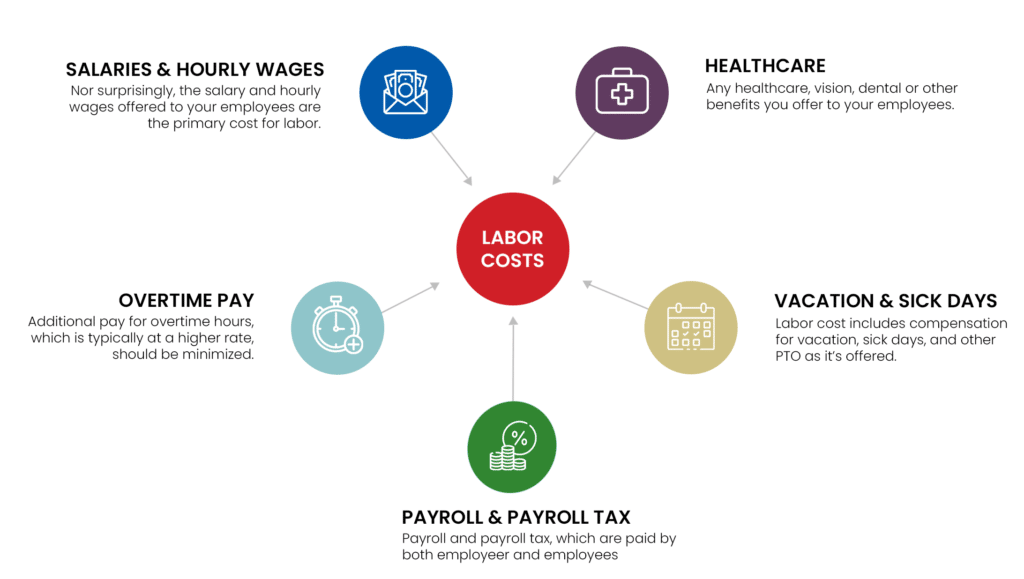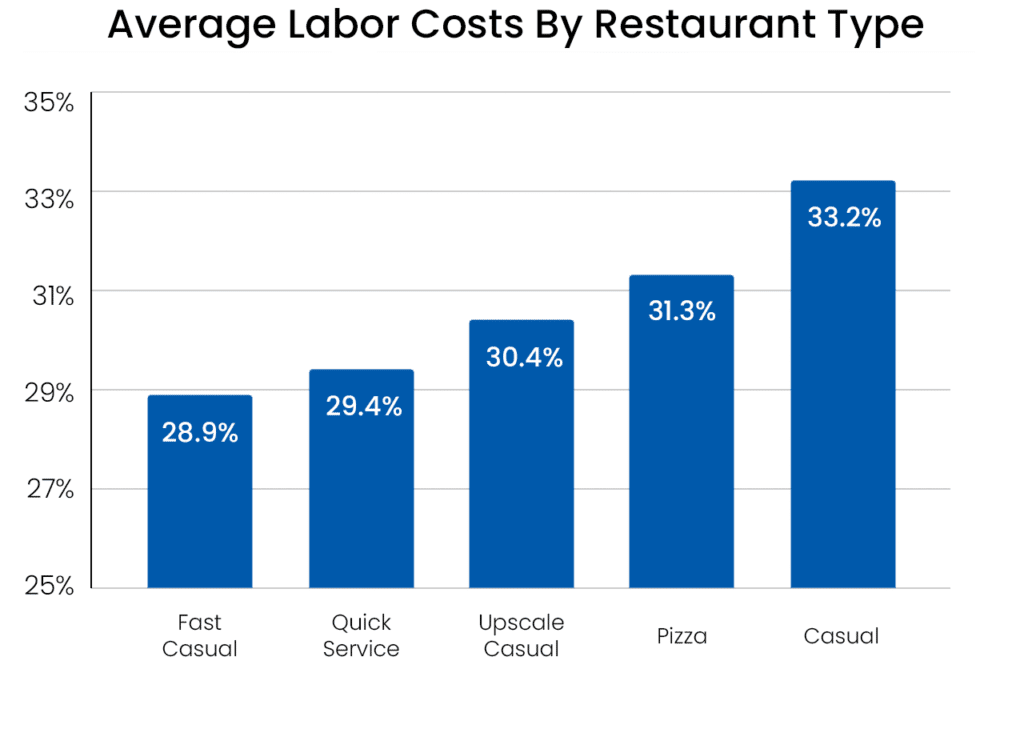By visiting our site, you agree to our privacy policy regarding cookies, tracking statistics, etc.
Rising wages make labor tracking more important than ever—learn how to monitor and improve your labor cost percentage.
Your restaurant labor cost and labor percentage are two of the most essential business metrics to track, especially as minimum wages rise around the country. Labor is one of the biggest expenses for a restaurant. With the many moving pieces in a restaurant, labor costs are also always changing, requiring daily, weekly, and quarterly tracking and reporting.
Labor cost is a significant part of your prime cost, a metric many restaurant owners use to analyze the efficiency of restaurant operations. Prime cost, made up of the total cost of goods sold (CoGS) and the total labor cost, represents most of the controllable expenses for a restaurant. Your prime cost, including your labor cost, is where you can improve to add more profit to your bottom line.
The methods for controlling restaurant labor costs vary by the type of restaurant. A quick service restaurant versus a full-service fine dining restaurant have different labor cost standards and require different approaches. As minimum wages rise around the country, location and locale also impact your restaurant labor cost. Knowing how to calculate labor cost percentage allows you to monitor this large expense and streamline your labor operations.
Your restaurant’s labor costs are more than just employee wages. They’re comprised of the total dollar amount spent on labor across your operation. Here are all the components involved in calculating labor costs:

There are different ways to calculate labor costs, but simply put, your labor cost percentage is the percent of your total sales that is spent on labor. You can calculate your labor cost percentage across different timeframes using our free calculator here.
You should aim to keep your labor costs somewhere between 28-33% of your total revenue. While this isn’t a steadfast rule – fine-dining establishes, for example, allocate much more to labor costs — spending too much on labor makes it much harder for your restaurant to turn a profit. Comparatively, a labor cost percentage that is too low indicates you’re not spending enough on your workforce, who are your most important asset to providing a top customer experience.
There’s a number of factors that can impact your labor costs. Your location, staff size, and efficiency can all drive cost in one direction. The type of restaurant concept you run will also impact labor costs, as different concepts require different skillsets and other fixed costs. According to accounting firm BDO, here are the average labor costs for some common restaurant concepts:

Not surprisingly, fast casual and quick serve restaurants have slightly lower labor costs, where employees can serve multiple customers more quickly and employees can often work across multiple areas. Upscale restaurants require higher labor costs, where employees are more specialized and often require more training.
A healthy percentage of labor costs guideline varies by industry and your particular restaurant’s business model. Most restaurants aim for labor cost percentage somewhere between 25%-35% of sales, but that goal may vary by restaurant industry segment:
While these industry benchmarks can be helpful to indicate your performance in the industry, every restaurant has different challenges, strengths, and sticking points.In addition, calculating labor cost as a percentage of sales may be a guideline, but it doesn’t provide all the detail necessary to implement improvements. For instance, different job categories may have completely different labor metrics, or a holiday or special event may skew your labor reporting. Knowing a number without understanding the big picture behind it can make it difficult to make improvements in the long-term. High labor costs can be the symptom of many different issues, and a quick fix of just cutting hours or paying low wages may only be a bandage on a deeper problem.
Understanding the story behind your labor cost is especially important as restaurant owners around the country address the repercussions of a rising minimum wage.
Restaurants all over the country, in different states, counties, and cities are experiencing new mandates and regulations raising the minimum wage. According to the New York Times, twenty nine states and the District of Columbia currently have state-level minimum wages higher than the federal minimum wage, making the effective minimum wage (what the average worker must be paid) at least $11.80 per hour.
Rising minimum wages come with regulatory complications about tipped, hourly, and other types of labor that can make a restaurant manager’s head spin. For example, beginning in 2020, the city of Seattle increased the minimum wage differently for different companies. Companies employing more than 500 workers have required minimum pay increases from $16 an hour to $16.39 per hour. Companies with fewer than 500 workers have required minimum pay increases from $15 to $15.75 per hour—if the company does not contribute $2.25 per hour to medical benefits or the employee does not earn $2.25 per hour in tips.For restaurant companies with locations in 10 states and 23 cities, keeping track of anywhere between 10 to 23 different minimum wages in each location for reporting purposes is a monumental task.
However, some restaurant operations software now offers tools to stay compliant with multiple minimum wage laws. Instead of spreadsheets or documents for each location, a minimum wage adjustment report can pull information for each employee underneath a selected job type to monitor the pay each employee should receive versus how much they earned. This allows restaurant owners to see the amount of money needed to pay a worker if they did not reach the minimum wage required.
This may seem like a no-brainer, but consistently reviewing your labor reports will give you greater insight into where you’re potentially wasting resources. No restaurant is perfect. And identifying instances where you’ve overstaffed or inaccurate scheduled shifts can highlight areas for improvement. Use sale data from your POS to identify shifts and employees where labor costs are higher than average.
It’s equally crucial to forecast wherever possible. We all know major holidays and big events require more staff. Similarly, winter and weekday lulls require less staff. But you can also get more granular. When is your daily rush? Changing your shifts by even an hour or two to compensate for these predictions can drive a big impact over time. What’s the weather this week? Are there any local events going on? Any time you’re able to predict these periods of varying labor needs, you’re setting yourself up for reduced labor costs. And day by day, shift by shift, this predictive scheduling can yield huge results at the end of the quarter or calendar year.
It’s unlikely you’ll be able to remove overtime completely, as employees aren’t always predictable. But anything you can do to minimizing overtime is an easy way to reduce labor cost percentage, as many state laws require employees to be paid 1.5x for working over 40 hours per week.
Using a restaurant technology platform, you can create a report that breaks down employee hours, the number of shifts worked, and the associated pay (among many other metrics). You should spend a few minutes every day reviewing this report in order to have a keen eye as to which employees are in danger of reaching overtime hours.
Using a predictive scheduling tool is crucial to avoiding too much overtime by scheduling in advance to know the labor you’ll need. It’s an investment that pays for itself quickly in reducing labor cost. And provides a better overall employee experience.
Training can often fall by the wayside in a busy restaurant environment. Many employees learn on the job with a trainer, which is necessary and can be effective to a certain degree. But you should also train staff on the basics of other area of your restaurant. While a server is probably not going to fill in for a line cook when someone calls in sick, every employee should be trained in the basic functions of helping your restaurant run.
We all know the turnover rates in the restaurant industry are high. And the multiple costs with hiring a new employee—from interviewing to training and onboarding—are huge. This is why it’s so important to have high retention. Offering competitive salaries is part of that equation, but there are other key benefits that keep people in the job:
Our free guide on Hiring and Retaining Restaurant staff goes into greater detail into some of these strategies, which will be useful in keeping your team fulfilled at your restaurant.
The right tools can drastically reduce labor costs. Implementing an all-in-one workforce solution means saving countless hours by turning manual tasks into automated ones that can be performed in a fraction of the time.
These tools allow you to manage schedules and shift changes, compare theoretical vs actual labor costs, and easily reduce overstaffing and overtime. It allows you to seamlessly manage your payroll tasks by integrating with your POS and integrates with your sales data so you can see trends between sales and different shifts.
This data is invaluable when it comes to reducing labor costs. Today’s successful restaurants are capturing this data and using it to implement changes and make improvements. If you’re managing your workforce in multiple Excel files, you should seriously consider investing in a restaurant management technology solution.
Workforce management is one of the more difficult and time consuming areas of running a restaurant business. It’s also not the most rewarding task, as it can take several weeks to see any changes in your labor cost percentage. But spending the time and implementing the right strategies in workforce management can have as big of an impact as reducing your COGS and therefore prime cost. If you make the effort, you’ll see the payoff as your margins start to rise.
Share this blog:
See why more than 40,000 restaurants use Restaurant365
Restaurant365 bridges the gap between accounting and operations by centralizing all data, helping restaurant operators to become more efficient, accurately forecast, and tackle any challenge or opportunity with speed and accuracy.